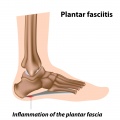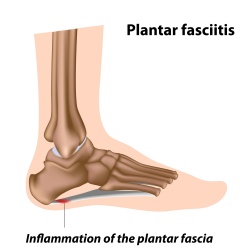Plantar Fasciitis
Plantar fasciitis is common injury involving the connective tissue running from the heel of the foot to the base of the toes. The plantar fascia is responsible for the strength and stability of the foot and is integral in the structure known as the arch of the foot. The plantar fascia is a common site of injury due to repetitive strain, and is often found in runners.[1]
|
Plantar Fasciitis | |
| Causes | Posture, Obesity, Exercise |
|---|---|
| See Also | Musculoskeletal Conditions |
| Books | Books on Muscle, Joint and Bone Conditions |
| Articles | Articles on Musculoskeletal Conditions |
Contents
Naturopathic Assessment
Causal Factors
| Article | Plantar Fasciitis: Diagnosis and Therapeutic Considerations , Alt Med; 2005;Vol10(2) |
|---|
In order to stimulate the innate ability of the body to heal the causes of disease must be identified and addressed. With plantar fasciitis, the causes are variable and include posture, muscle imbalance, and repetitive strain. A detailed assessment is required to determine which factors are contributing to the development and progression of plantar fasciitis.
Lifestyle
- Runners are particularly prone to the development of plantar fasciitis. Increases in intensity of activity, or changes in normal routine are common causes for the sudden development of plantar fasciitis.[1]
- Obesity is a risk factor for the development of plantar fasciits.[3]
External
- Occupation
- Occupations requiring standing and/or walking for long periods of time increase the risk of plantar fasciitis.
- Footwear
- Improper footwear, particularly footwear with loose heels, and inadequate arch support can predispose individuals to the development of plantar fasciitis.[1]
Diagnostic Testing
Plantar fasciitis is most commonly a clinical diagnosis, although the following diagnostic procedures may be useful to rule out alternate differential diagnoses and co-morbidities or to guide surgical care:[1]
- Imaging studies including radiographs, ultrasound, and MRI.
- Other studies including electrodiagnostics (electromyography).
Related Symptoms and Conditions
Plantar fasciitis is often associated with the following conditions:[1]
- Heel Spurs
- Pes planus (flate feet)
- Pes cavus (high arches)
- Pronation
- Obesity
- Achillles tendon fracture
Characteristics
The plantar fascia originates at the tuberosity of the os calcis (just beside the heel pad) and runs to the base of the toes. Injury to the fascia typically involves microtears at the origin. Although it was originally thought that inflammation played a key role, recent evidence suggests it progression is a degenerative process rather than inflammatory in nature.[1]
Plantar fasciitis is characterized by:[1]
- Sharp pain at the heel base
- Pain on first movement in the morning
- Pain decreasing during exercise
- Numbness
- Weakness
- Tenderness along plantar aspect of foot
- Limited range of motion of big toe
Naturopathic Treatment
The goal of naturopathic treatment is to support and work in tandem with the healing power of the body and to address the causal factors of disease with individual treatment strategies. Plantar fasciits is typically a recurring issue for affected individuals and needs both acute treatment and modification of long-term risk factors.
It is always advisable to work with a naturopathic doctor before engaging in any treatment plan.
Lifestyle
Lifestyle recommendations include:
- Weight Loss
- Obese individuals can reduce the recurrence of plantar fasciitis by losing weight.[3]
- The use of supportive sneakers with a firm cushioned sole is recommended, as well as the use of custom orthotics to limit pronation and correct improper biomechanics.[3]
- Addressing all postural imbalances may help decrease the frequency of plantar fasciitis attacks.
- Strength training targeting the lower leg, foot, thigh, hip, back are an important aspect of rehabilitation in individuals with plantar fasciitis.
- A commonly used exercise aimed at increasing strength of intrinsic foot muscles includes rolling a towel by flexing and extending the toes or alternating heel and toe raises.
- Walking backwards on a flat surface for about 5 minutes a day may be beneficial.
- Rolling foot on a golf ball or a ball designed for foot exercises can assist in loosening the plantar fascia.
- Reducing running time and replacing jogging with cardiovascular activities such as swimming or cycling is recommended.
Naturopathic Therapies
Naturopathic Therapies for plantar fasciitis include:
- Vitamins such as Vitamin C
- Minerals such as Zinc
- Other supplements such as Bromelain, Glucosamine, Omega-3 Fatty Acids
- Botanical remedies such as Devil's Claw (Harpagophytum procumbens), Ginger (Zingiber officinale), Willow Bark (Salix spp)
- Homeopathic remedies such as Causticum, Graphites, Medorrhinum, Mag phos
- Studies suggest that acupuncture may be beneficial in individuals with plantar fasciitis.[5]
References
- ↑ 1.0 1.1 1.2 1.3 1.4 1.5 1.6 1.7 Pasquina PF, Foster LS (2008) Frontera: Essentials of Physical Medicine and Rehabilitation 2nd ed Chap 86 Plantar Fasciitis Saunders
- ↑ Irving DB, Cook JL, Young MA, Menz HB (May 2007) Obesity and pronated foot type may increase the risk of chronic plantar heel pain: a matched case-control study. BMC Musculoskelet Disord. PMID: 17506905
- ↑ 3.0 3.1 3.2 Ferri: Ferri’s Clinical Advisor 2013 1st ed Plantar Fasciitis Mosby
- ↑ Roxas M (2005) Plantar Fasciitis: Diagnosis and Therapeutic Considerations Alt Med Rev;10(2):83-93.
- ↑ Zhang SP, Yip TP, Li QS: Acupuncture treatment for plantar fasciitis: a randomized controlled trial with six months follow-up [published ahead of print November 23, 2009]. Evid Based Complement Alternat Med.
- ↑ 6.0 6.1 Cole C, Seto C, Gazewood J (2005) Plantar Fasciitis: Evidence-Based Review of Diagnosis and Therapy Am Fam Phys; 72(11)

